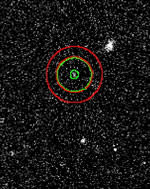
Image credit: UBC
A team of Canadian astronomers have discovered even more new satellites for Jupiter, giving the giant planet a total of 61 moons – 21 were discovered just this year. These new satellites are harder to detect because they’re only 1-5 kilometres across and have wide, irregular orbits around Jupiter. The team took a mosaic of images around the entire sky of Jupiter, and then used a computer to search for points of light that had the motion of a Jovian moon.
They were small and hard to find, but with the help of some new telescopic equipment and cameras, UBC professor Brett Gladman, UBC postdoctoral researcher Lynne Allen, and Dr. J.J. Kavelaars of the National Research Council of Canada have discovered nine previously unknown moons of Jupiter. So far this year, 21 new Jupiter moons have been identified.
The discovery of the distant satellites, announced today at the annual meeting of the Canadian Astronomical Society, boosts the number of known moons on Jupiter to 61 — more moons than any other planet in the solar system.
“The discovery of these small satellites is going to help us understand how Jupiter and the other giant planets formed,” said Gladman, a Canada Research Chair in Planetary Astronomy.
The new satellites were a challenge to detect because most are only about 1-5 kilometers in size. The feeble amounts of light they reflect back to earth must compete against the glare of brilliant Jupiter. Their small size and distance from the Sun prevent the satellites from shining any brighter than 24th magnitude, about 100 million times fainter than can be seen with the unaided eye. To locate these new moons, Gladman’s team used the new Megaprime mosaic of CCD cameras at the 3.6m Canada-France-Hawaii telescope on Mauna Kea, Hawaii.
The mosaic camera enabled the team to take three images of the entire sky around Jupiter. They used computer algorithms to search the images for the faint points of light moving across the sky as moons should.
Because moons can sometimes appear in front of distant stars or lost in the light scattered from the planet, to find them requires painstakingly repeating the search several times. The team undertook the task between February and April 2003.
International members of the jovian search team include Cornell University astronomers Phil Nicholson, Joseph A. Burns, and Valerio Carruba, Jean-Marc Petit of the Observatoire de Besancon, and Brian Marsden and Matthew Holman of the Harvard-Smithsonian Center for Astrophysics.
Original Source: UBC News Release

I believe that many of these new found satellites of jupiter wasn’t over looked in the past for whatever technological reasons but have been gathering due to jupiters gravitational force. There will always be new satellites to discover from jupiter. The planet is always pulling them in. Is it possible that our solar system was pulled together because of jupiter. The sphere (the shape it self) i believe holds the true key to the universe. Am i the only one to believe that we, as in earth and our solar system, is a “planet” within a planet (sphere) with in another (and so on)? Is there “something” or “someplace” beyond the darkness(space)?